COMMENTS ON THE ART MARKET
Current Gallery Exhibition
The Art of Subversion
Through October 11th
The Goal of Subversion
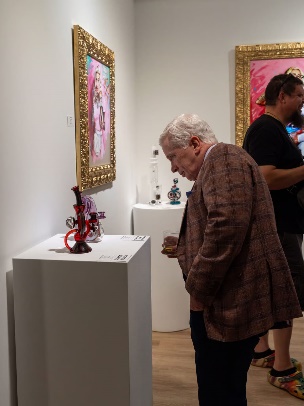
Last Friday, September 13th, Rehs Contemporary Galleries opened their exhibition, The Art of Subversion. While the show has a coherent aesthetic, it may not be easy to nail down the goal of curating such an exhibition. Simply viewing the work online would not explain why street art-inspired paintings are displayed alongside pieces of functional glass sculpture. What do they mean by subversion, and why is it essential enough to dedicate an entire gallery show? Subversion, in this context, refers to highlighting and appreciating taboos and stigmas within the arts and beyond, including graffiti, tattoos, functional glass art, and other subjects and media. Not only is the exhibition applying a magnifying glass to subversive art, but in doing so, the exhibition itself is an act of subversion. The goal of The Art of Subversion at Rehs Contemporary is to offer the platform and vehicle of a gallery setting to subjects and genres that, in the past and even today, are unwelcome in such spaces.
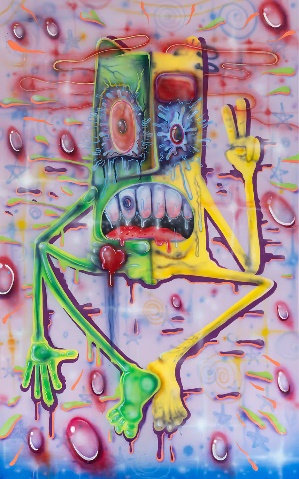
Emotions of the Hooligan
by Lenny Vuitton
Street art is probably the main source of inspiration for the graphic art on display. Conversations surrounding street art are incredibly nuanced and have evolved greatly over the past decade. Until Banksy became a household name, brick walls and overpasses in the world’s urban centers were where you would find the best street art and graffiti, not on the auction block at Christie’s. Of course, street art has inspired or served as a starting point for some of the great modern artists of the last fifty years, most notably Keith Haring and Jean-Michel Basquiat. However, until Banksy, street artists had to move off the street and into a studio to gain greater legitimacy, success, and name recognition. Yet despite the success of Banksy and the incorporation of street art and graffiti into contemporary art collecting and connoisseurship, there is still work that must be done. Many in the worldwide street art scene have commented that there is still room for greater normalization and legitimization. Banksy is sometimes seen not as a forerunner of greater change but as merely a prominent graffiti artist for whom society and law enforcement make an exception. Works by world-famous street artists are preserved and admired, while others are covered and painted over. One incident last year in Glasgow clearly showed this double standard when a piece of graffiti was only painted over after the local council learned it was, in fact, not by Banksy but by a duo seeking to imitate the anonymous artist’s style. Some towns and cities are already providing designated spaces where graffitists can work freely. So, allowing street artists to exhibit their work in a gallery provides legitimacy, eases the stigma against graffiti, and brings these artists’ work to an entirely different audience.
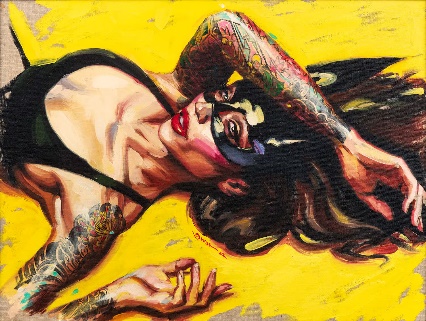
Lucky Black Cat by Chris Guest
Among the artists represented in The Art of Subversion, Chris Guest pulls from a very different art form that mainstream fine art spaces also exclude. Scantily clad and nude women are nothing new in traditional Western art. However, graphic art that is more sexually explicit, like pinups and erotica, has always had a hard time breaking through, regardless of the artist’s skill. Guest captures the subjects and aesthetics of centerfold photographs and other genres dismissed as smut using the traditional medium of oil paints on canvas. Furthermore, while academic nude painting shows idealized proportions and perfectly clear skin, Guest subverts the genre of conventional figure painting by using subjects with elaborate tattoos. This brings us to another taboo addressed in The Art of Subversion. Though tattoos are becoming more widely accepted and of great cultural significance among some peoples, like the Maori of New Zealand, tattoos are often associated with outcasts and other marginalized groups. In many cultures, it is associated with criminality, especially in places like Japan, where the practice is closely associated with organized crime. But even in times and places where tattoos were nearly completely kept on the periphery, those at the center of high society couldn’t help themselves. Despite the taboo, European royals often got tattoos while traveling abroad. King Edward VII of England and his son King George V each had a five-fold cross tattooed on their arms, both done by the same tattoo artist in Jerusalem about twenty years apart. While on a trip to Japan, Czar Nicholas II had a dragon tattooed on his right arm, which can be seen in some photos. Exceptions like these show that long-standing stigmas that still persist today are never as cut and dry as they seem.

White Crush by Buck
As I’ve discussed in a previous article, the difference between what is and is not fine art often concerns purpose. Many beautiful pieces are excluded from the fine art category because they have a practical, useful role. Jewelry, pottery, ceramics, textiles, and glass are kept out of the fine art club. One of the central components of The Art of Subversion is functional glass sculpture. Not only has this form of art been excluded from gallery spaces because it has a practical purpose, but there is also the taboo associated with smoking culture that has only started to fade in the past decade or so because of cannabis decriminalization and legalization efforts. Many visitors reacted similarly to seeing these pieces: as beautiful and complex as some of these pieces are, the practical purpose almost seems secondary. This is most apparent in the work by Buck, Hamm Brushland-Vitrifex, and JP Toro. When placed in the right context, they are perceived more as genuine works of art than objects serving a practical function. This makes it an even greater shame that this sort of work is, in some jurisdictions, not just stigmatized but outright illegal and classified as drug paraphernalia. It only makes it more difficult for these incredibly skilled craftsmen to make a living.
Every once in a while, bringing in outsiders is the best way to breathe new life into any establishment. By exalting the marginalized, the stigmatized, and the subversive, we help push visual art into new and exciting directions by injecting it with experimentation and fresh perspectives. In a counterintuitive way, you need a little subversion to move forward.
____________________
Stocks & Crypto
We got some good news and some bad news, what do you want first?
Ok, the bad news… summer is officially over. Ok, maybe that’s not exactly news, but where does the time go?! Make it stop!
Now for the good news… about a week into the month, it looked like we were on pace for the usual September slowdown – historically, it’s the worst month on average for the stock market. By the end of just the first week, all three indexes had experienced a sizable slide – the Dow was down 2.4%, the S&P was down 3.3%, and the NASDAQ was down over 4.7%! But as mentioned, this is the good news part… that trend quickly reversed and held strong through the remainder of September. In fact, both the Dow and S&P notched fresh record highs. When all was said and done, those figures were all on the plus side - +2.4%, 2.4%, and 3.25%, respectively. Eh, I guess we still have one more day of the month on Monday, but I’m hopeful we’ll still land in positive territory.
On top of that, the metrics show inflation has been cooling – last month, it fell to 2.2%, just above the Fed’s target of 2%. That gave enough ground for the Fed to slash interest rates by 50 basis points; there is still the potential of another rate before the end of the year in November. The one odd part about this is the bond market… curiously, the 10-year note yield has actually crept upward following the rate cut, which is unusual. It’s been explained away as the market pricing in “too much” easing before the rate cut, but it definitely is a bit odd and worth keeping an eye on.
Turning to currencies and commodities… the Pound and Euro followed similar paths, initially dipping about 1% relative to the dollar before gaining some strength; they ended up 1.3% and 0.35%, respectively. Crude dipped down into the 60’s, which was a nearly 10% slide through September. On the other hand, gold futures continue to test the limits, as it repeatedly set record highs; it now sits just shy of $2,700 after a nearly 6% gain this month.
There was some volatility in the crypto arena this month, but ultimately, things trended up… Bitcoin is back into the mid-$60k ballpark after climbing more than 10%. Ethereum and Litecoin performed similarly but gained just 7.25% and 8.7%, respectively.
Hopefully, this is all a sign of what is to come… with September bucking the trend as a loser, perhaps the remainder of the year will be a bit smoother than expected, especially with an election less than six weeks away.
____________________
Really!?
Ruth's Called Shot

Babe Ruth’s Jersey
Babe Ruth’s legendary called shot from Game 3 of the 1932 World Series has captivated baseball fans for nearly a century. But recently, the jersey Ruth wore during that iconic moment made its own headlines, expected to fetch a staggering $30 million at auction. While it didn’t quite hit that lofty mark, the final sale price was still jaw-dropping.
Let’s rewind to October 1, 1932: the Yankees faced off against the Chicago Cubs at Wrigley Field. In the fifth inning, with the crowd jeering and Cubs players taunting him, Ruth allegedly pointed towards the center field bleachers before launching a home run off Cubs pitcher Charlie Root. Whether he really “called his shot” has been debated for decades since some claim that Ruth was perhaps gesturing towards Root or the Cubs bench instead. But what’s not in question is that Ruth’s homer helped the Yankees win 7-5. The next day, they swept the Cubs to take the World Series, making the called shot Ruth’s last home run in postseason play. Ever since, a batter calling their shot in the manner of Babe Ruth has been referenced and parodied in countless works of sports media.
Now, about that jersey. In typical Babe Ruth fashion, sometime around 1940, he casually gifted the historic garment to a golfing buddy in Florida. The jersey stayed in that lucky family’s hands until the early 1990s when the buddy’s daughter sold it to a collector. It first hit the auction block in 2005, selling for what now seems like a mere $940K. It seems that the golfing buddy did not know he owned the called shot jersey, or that information was simply forgotten. When someone photo-matched the jersey to Ruth’s iconic “called shot” game, the connection sent its value soaring. The jersey took center stage at an auction this past August, and after a fierce bidding war, it sold for an incredible $24.12 million.
While it didn’t quite “call its shot” for $30 million, $24.12 million isn’t exactly a bad day at the plate.
____________________
Artist Awards
Alexandra Klimas Wins Best In Show
In recent years, Alexandra Klimas has become known for her hyperrealistic portraits of barnyard animals, mainly cows. We excitedly share that Alexandra recently won Best in Show at the All Animals Art Awards organized by the Camelback Gallery for her painting Susanne the Cow – the original painting can be seen at our gallery in New York.
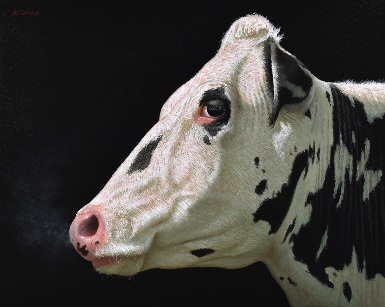
Susanne the Cow
by Alexandra Klimas
By creating close-up portraits of barnyard animals, Klimas transcends some of the old conventions of animal painting. Unlike the work of her predecessors, like Rosa Bonheur and David Shepherd, Alexandra frames her subjects in a way that allows us to view them not as beasts of burden or food sources but as living beings with individuality and personality. Klimas’s intentional focus on barnyard animals is a reflection of a larger goal of recognizing and respecting animals that she sees as forgotten. “Pets are pampered and adored, but we are spared of images of animals for the meat industry. […] I try to paint my cows so lifelike that they look at you and a kind of intimate relationship is created.” Like with her other animal portraits, Klimas based Susanne on a real cow she observed at the Dutch farms she frequently visits in the summertime. During these excursions, she writes brief descriptions beside her sketches, commenting on the animals’ temperament and identity.
Even when we aren’t looking at the animals face-to-face, they are still painted as individuals rather than members of vast herds. Klimas may paint the cows Lieke and Aline in the field against the sky’s great blue and white expanse, yet Alexandra shows them not as indistinguishable parts of a larger whole but as two unique living beings. With Susanne, though, Klimas gives us an incredibly intimate look at the cow. Unlike her other cow paintings, Klimas shows Susanne in profile against a completely black background. The subject in profile against a monochromatic background gives off the feeling of Renaissance portraiture, namely the style popular among fifteenth-century women in Tuscany. It indicates Klimas engaging in a dialogue that transcends a mere depiction of animals. It hints at something more profound, something that attracts people to her work.
____________________
The Dark Side
Chinese Artist Gao Zhen Arrested For ‘Defaming Heroes’
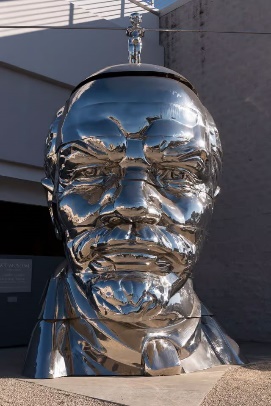
Miss Mao Trying to Poise
Herself at the Top of Lenin’s Head
by the Gao Brothers
One of China’s most prominent artists, Gao Zhen, has been arrested for criticizing the country’s respected historical figures.
Gao is well-known in China for his work with his brother, Gao Qiang. The Gao Brothers have been active as artists since the mid-1980s, using media such as painting, sculpture, and performance art. Social and political criticism is common in their work, likely influenced by their upbringing during the Cultural Revolution. This was an effort by Mao Zedong to solidify state socialism’s place in China by purging capitalist and some traditional aspects of Chinese culture. Students formed Red Guards and revolutionary committees to root out these influences. The Gao Brothers’ father was arrested and allegedly committed suicide in prison during this time. Other Chinese artists of the same generation as the Gao Brothers had similar upbringings, including Ai Weiwei.
The Cultural Revolution and its legacy are common themes in the Gao Brothers’ work. Some of their early work is meant to commemorate the victims of the 1989 Tiananmen Square Massacre. This kind of art has become increasingly rare in China under Xi Jinping, who has cracked down on dissent in his attempts to consolidate power. In 2018, China’s National People’s Congress passed a law criminalizing defamation of the country’s “heroes and martyrs”. Xi spearheaded efforts to augment the law in 2021. During that year’s Communist Party anniversary celebrations, Xi emphasized the party’s purpose “to vigorously carry forward the red tradition”. Government prosecutors have used these laws to target high-profile dissidents such as artists, journalists, and activists for their work as government critics. However, the state may also target random people for their social media posts.
Gao Zhen has lived in the United States since 2022. He was visiting family in China last month when police arrested him in Sanhe, a town just east of Beijing. Gao Qiang stated that authorities also raided their studio and confiscated several of their artworks. Most of these confiscated works are over a decade old, predating the law that Gao is accused of violating. Many of these pieces use Mao Zedong’s likeness and recall the legacy of the Cultural Revolution. Qiang has called the raid a “retroactive punishment for actions that took place before the new law came into effect”. He further commented that the brothers have actually stopped creating work relating to the Cultural Revolution as they are “completely exhausted from dealing with [its] ghosts”.
When you’re heading an authoritarian regime, suppressing dissident artists as a knee-jerk reaction may seem logical. However, in arresting them and confiscating their work, the government proves the point they make through their art. Gao Zhen faces up to three years in prison due to his work.
Jail Time For Morrisseau Forger
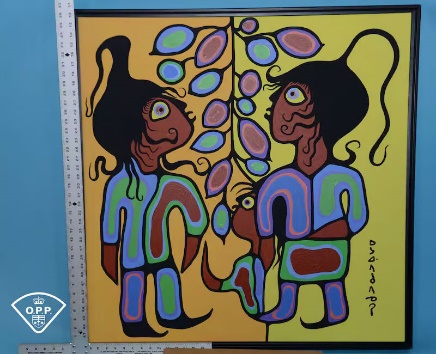
A confiscated Morrisseau forgery
(courtesy of the Ontario Provincial Police)
A Canadian court has sentenced one of the ringleaders of the forgery ring that produced countless fakes and forgeries in the style of the Indigenous artist Norval Morrisseau.
When I first started writing about the discovery of the Norval Morrisseau forgery ring in Canada, I wasn’t anticipating that I would be writing about it over a year and a half later. But as a brief update on how things got this way: in March 2023, police in Ontario arrested the forgers and their conspirators for creating thousands of fake paintings. Morrisseau was an incredibly influential artist who was credited with bringing Indigenous art into the mainstream in Canada. He has been dubbed by many “the Picasso of the North”. Before he died in 2007, he founded the Norval Morrisseau Heritage Society (NMHS) to counteract forgeries. In 2019, a lawsuit against the Maslak McLeod Gallery in Toronto over a fake Morrisseau painting piqued detectives’ interest. In the end, they uncovered a forgery assembly line, with conspirators recruiting Indigenous artists to create works in Morrisseau’s style. Some estimate that, partially because of the group’s work, there are probably ten times more forgeries than legitimate Morrisseau works on the market today. Gary Lamont, the main organizer of the forgery conspiracy, pled guilty to forgery, making false statements and defrauding the public, and received five years in prison.
In June of this year, one of the other ringleaders, David Voss, pled guilty to the charges against him and just recently received his sentence. While Lamont was considered the enterprise’s overall leader, Voss worked out the details, such as organizing the assembly line and directly overseeing the production of the Morrisseau forgeries. Like Lamont, he received five years in prison for his activities. Judge Bonnie Warkentin stated that Morrisseau’s artistic legacy has been “irrevocably damaged” due to Voss’s crimes. Corey Dingle, executive director of the NMHS, called Voss’s activities “a cultural crime that goes beyond financial losses, reaching into the heart of Indigenous heritage.” Dingle also notes the NMHS has faced many challenges during this difficult time for the organization. The scandal has made Morrisseau a third rail in the Canadian arts. Both academics and gallerists are hesitant to study or exhibit work attributed to the artist, resulting in the NMHS slowly becoming a pariah organization.
Police have confiscated over 1,600 forgeries so far, with many more still unidentified. Despite the damage done by the forgeries, not only to buyers and collectors but to art lovers, scholars, and Canada’s Indigenous peoples, prosecutors decided they would not pursue a restitution order for Voss and his co-conspirators due to the complexity of the case. Four others still have charges against them. Two other individuals, Linda Tkachyk and Diane Marie Champagne, were initially arrested with the others involved, but later their charges were dropped. The next update in the case we will likely hear is the court date set next month for Benjamin Morrisseau, nephew of the artist who had a hand in the scheme.
Frankenthaler Foundation Lawsuit Dismissed

Helen Frankenthaler
receiving the National Medal of Arts
A New York judge has dismissed the lawsuit against the Helen Frankenthaler Foundation brought by its former president.
I have previously covered the Frankenthaler Foundation lawsuit, explaining its origins and detailing its progress. To recap, Frederick Iseman, the artist’s nephew and former president of the foundation, is attempting to sue not only the foundation but also its board members to, from his point of view, save the organization from destruction. Iseman alleges that the board members who ousted him as president in 2023 have taken advantage of the organization’s reputation and Helen Frankenthaler’s legacy to benefit their own careers and endeavors. In his initial complaint, Iseman accuses his cousin and foundation board member Clifford Ross of operating a pay-for-play system through the foundation where donations and grants would be given to cultural institutions that agreed to host shows of his work. The artist’s stepdaughter, Lise Motherwell, is accused of failing to organize any significant Frankenthaler exhibitions at a major museum, demonstrating her ineptitude as a foundation board member. However, Motherwell managed to save face slightly after announcing a major retrospective in 2028 at the National Gallery of Art in Washington, DC, to commemorate Helen Frankenthaler’s one-hundredth birthday. Finally, there are accusations against Michael Hecht, including conflicts of interest in using his accounting firms for foundation business.
The upcoming Frankenthaler retrospective at the National Gallery has been the subject of much of Iseman’s recent commentary. Though not in his lawsuit, he has launched additional allegations at the foundation board members regarding how they may have secured this exhibition. The retrospective has not yet been formally announced. Still, the National Gallery let it slip during an announcement that Harry Cooper would step down as head of the modern and contemporary art division to take on a new role as an endowed modern art curator. Iseman alleges that the major Frankenthaler painting currently on long-term loan to the museum, the 1952 work Mountains and Sea, may have been used to secure the exhibition, promising to donate the painting to the gallery in exchange. Iseman speculates that should this be the case, it is “a desperate attempt to buy the retrospective of my aunt’s art that they have promised for years but have been unable to deliver”. Roberta Kaplan, Iseman’s lawyer, wrote that such a deal would be “a scandalous breach of the director defendants’ fiduciary duties and entirely contrary to [the foundation’s] mission”.
Judge Jennifer G. Schechter of the New York State Supreme Court dismissed the lawsuit due to lack of standing. Since Iseman is no longer a board member, he is not in a position to bring this suit. A foundation spokesperson called the lawsuit a “vengeful vanity exercise”. Iseman has until today, September 18th, to file an opposition. He noted that the dismissal did not comment on his accusations’ merits but rather concerned a “narrow procedural issue”. Iseman is still concerned that the remaining board members intend to carry out their alleged plans, which include selling off important Frankenthaler works in the foundation’s hands by 2030 and completely liquidating the organization by 2034. He seems confident that he will regain some lost ground on appeal. “I remain steadfast in my efforts to protect my mother’s sister, Helen Frankenthaler’s, distinguished place in the history of art”. Judge Schechter did comment that despite Iseman’s lack of standing, should there be substance to the complaint’s allegations, New York’s attorney general would be the person to investigate any foul play at the Frankenthaler Foundation.
Performance Artist Smashes Ai Weiwei Sculpture

Ai Weiwei
(photo courtesy of Otto Woods)
On the opening night of a new Ai Weiwei exhibition in Bologna, a visitor pushed over a sculpture, completely destroying it.
The incident occurred at the Palazzo Fava last Friday, September 20th, during the opening of Ai’s exhibition, his first-ever solo show in Bologna. Among the works on display was Porcelain Cube. Ai posted CCTV footage of the incident on his Instagram page, which shows the perpetrator knocking over the sculpture and holding a piece over his head in some sort of performance. Ai was in the next room when the destruction took place. “I rushed inside to find chaos.” He later called the act “unacceptable”, and lamented that additional security would not have prevented the sculpture’s destruction.
Following the incident, police arrested a 57-year-old Czech man named Vaclav Pisvejc. Arturo Galansino, the director of the Fondazione Palazzo Strozzi in Florence who also curated the Ai exhibition, told reporters that this is not the first time Pisvejc has caused a scene. He is an artist himself, mainly creating abstract portraits that seem like mixes between Willem de Kooning and Francis Bacon. In 2018, Galansino organized an event at the Palazzo Strozzi for the performance artist Marina Abramović. Pisvejc approached Abramović with a portrait of her that he had created, hitting her over the head with it. Pisvejc has pulled off other provocative stunts, including standing naked in the Piazza della Signoria in Florence until police took him away. In that same square, during an art show several months later, Pisvejc sprayed red paint onto Urs Fischer’s sculpture Big Clay #4, making a large spot that remained for some time. In 2022, Pisvejc set fire to the black shroud the city of Florence had draped over the copy of Michelangelo’s David in front of the Palazzo Vecchio (done in commemoration of the victims of Russia’s invasion of Ukraine).
The exhibition, titled Who Am I?, explores Ai’s “constant tension between tradition and experimentation, preservation and destruction”. Several works featured in the exhibit deal with the theme of destruction, including Left/Right Studio Material and Dropping a Han Dynasty Urn. Of course, with few exceptions, destroying a work of art is in poor taste regardless of the perpetrator’s reasons. But with China’s government increasingly putting its boot on the neck of the country’s cultural sector, damaging or destroying cultural items by a prominent Chinese dissident artist is in extremely poor taste. It almost trivializes the repression artists face at the hands of restrictive governments. Few people seem to support Pisvejc and his work, so this will make him an even greater social pariah. Actions like this make gallery and museum spaces seem unsafe when they are meant to provide a secure environment to exhibit and interact with art.
____________________
The Art Market
Phillips David Hockney Sale
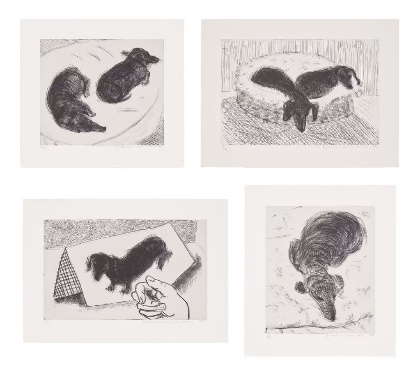
Selections from Dog Wall
by David Hockney
After a quiet August, the auction house scene in London is starting to pick back up again, with Phillips hosting several modern and contemporary sales this week. While their Evening Edition was good to watch, their David Hockney sale on Thursday, September 19th, drew some attention, for good and for bad. A sale dedicated to a single artist’s work is not unusual. Depending on the auction house, lone sales are often dedicated to prolific artists like Banksy and Marc Chagall. Thursday’s sale is not the first time Phillips has hosted an auction devoted to David Hockney’s work. However, while these sales are normally easy successes for Phillips, this most recent one fell a little short at the end.
The sale was relatively successful, with most of the sixty-one available lots selling within or over their estimates. One of the reasons why Phillips can host David Hockney’s sales nearly every year is because of the artist’s extensive output of prints and multiples, including the iPad drawings he’s created in more recent years. The sale’s top two lots consisted of complete collections of such prints. In the number one spot, a series of fifteen etchings from 1998 called Dog Wall is a tribute to Hockney’s dachshunds, Stanley and Little Boodgie. Dog Wall was originally estimated to sell for between £200K and £300K, selling for exactly in between at £250K / $330K (or £317.5K / $420.1K w/p). The second-place lot was a series of sixteen etchings and aquatints called A Rake’s Progress. The series bears the same name as a series of paintings by the eighteenth-century English artist William Hogarth, showing the story of a wealthy young man and his descent into debauchery that lands him in prison and then an asylum. Hockney’s version, completed in 1963, is a more modern take on a similar story inspired by a trip to New York he took in 1961. Like Dog Wall, Phillips specialists assigned the series an estimate range of £200K to £300K. A Rake’s Progress eventually hammered at the low estimate (or $264.6K; £254K / $336.1K w/p).
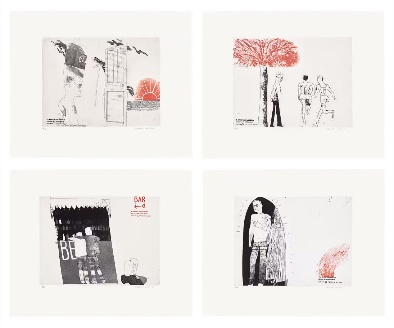
Selections from A Rake’s Progress
by David Hockney
The third-place lot is an example of Hockney’s recent work. The iPad drawing is part of a series of digital drawings Hockney made in 2011 called The Arrival of Spring in Woldgate. It shows scenes along the titular road in Hockney’s native Yorkshire. Hockney would create these works on his iPad before making them into physical prints. Some examples from the series have previously sold at auction for as high as £500K w/p, primarily at Phillips but also at Sotheby’s, Christie’s, and Bonhams. Hockney applies his unnaturally bright color palate to simple landscapes and natural scenes that make forests and country roads unforgettable. Hockney created the example offered at Phillips on April 30, 2011. Phillips initially gave it an estimate of £70K to £90K. However, the print eventually sold for over 50% more than the high estimate at £150K / $198.5K (or £190.5K / $252.1K w/p).
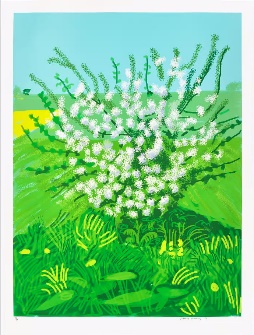
The Arrival of Spring in Woldgate,
by David Hockney
And, of course, the sale was not without its surprises. Four Lots sold for more than double their High estimates, with one example being a work called Swimming Pool Carpet. This is an actual rug Hockney designed, measuring nearly ten by six-and-a-half feet. Although estimated to sell for no more than £7K, interest in the piece pushed the final hammer price up to £18K / $23.8K (or £22.8K / $30.2K w/p). Twenty-one of the sixty-one available lots sold within their estimates, giving Phillips specialists a 34% accuracy rate. An additional twenty-four lots (39%) sold above, while twelve (20%) sold below. Although the David Hockney sale did well in several ways, the total amount brought in fell short of expectations mainly because of a single lot that went unsold. Only four of the sixty-one available lots were bought in, giving the sale a sell-through rate of 93%. However, among these unsold works was another print from the Arrival of Spring in Woldgate series, created on May 16, 2011. While the April 30th entry shows a bush of white flowers, the May 16th shows Woldgate itself. The road is a far more recognizable subject from the series, explaining the pre-sale estimate range of £280K to £400K. With the May 16th print going unsold, the sale overall failed to meet the pre-sale £1.46 million minimum estimate. It did get close, reaching £1.4 million / $1.86 million.
Bonhams London 19th-Century
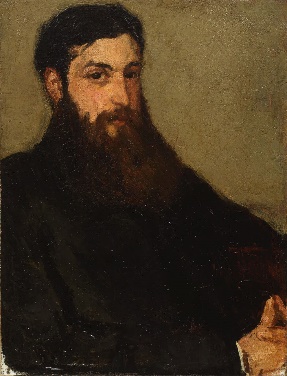
Portrait of Lucas Alexander Ionides
by James McNeil Whistler
On Wednesday, September 25th, Bonhams hosted their sale of nineteenth-century paintings at their New Bond Street location. With ninety-seven available lots, the auction did relatively well, except for the highest-valued work disappointingly going unsold. Close to two-thirds of the lots up for grabs had a minimum estimate under £10K, making the high-value lots stand out by comparison. The auction’s top lot was a rare portrait by the American painter James McNeil Whistler. Paintings by Whistler are not often seen at auction since few of his paintings of note are in private hands. The last time a painting attributed to Whistler sold at auction was January 2023 when Howth Head, Near Dublin sold at Christie’s New York for $190K hammer. Portrait of Lucas Alexander Ionides, therefore, proved popular with bidders when it came across the block. It brought in more than double its £120K high estimate, hammering at £320K / $428.7K (or £406.8K / $544.9K w/p).
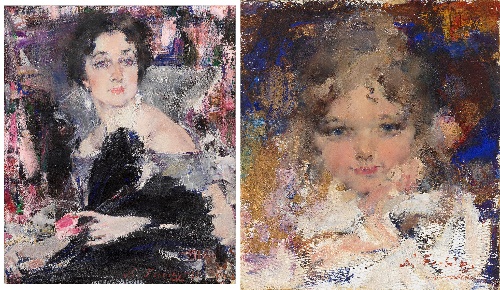
Portrait of Mademoiselle Ducter (left)
and Portrait of artist’s daughter Eya (right),
both by Nikolai Fechin
The Whistler was followed by two paintings by the Russian artist Nikolai Fechin. Like much of Fechin’s work, both are portraits using his characteristic style of thick impasto and a chaotic mess of brushstrokes making up the background. Portrait of Mademoiselle Ducter dates to 1925, after fifteen years of Fechin living and working in the United States. Meanwhile, Portrait of artist’s daughter Eya was likely created a few years before. Children were some of Fechin’s most prolific subjects, with his daughter Eya appearing in much of his work. Bonhams expected Mademoiselle Ducter to do particularly well, with specialists assigning the painting a £300K to £500K estimate range. While it fell slightly short of these expectations at £280K / $375.1K (or £356K / $486.9K w/p), it still wound up the sale’s second-place lot. Eya, on the other hand, hammered at the £150K low estimate ($200.9K; or £190.9K / $255.7K w/p). Eya ended up sharing the third-place spot with another painting, this one by the British landscape painter John Atkinson Grimshaw. A Golden Idyll is very typical of the artist’s work, with the predominant use of yellow hues to convey a sense of twilight in an urban or suburban setting. Sharing the third-place spot, A Golden Idyll has the highest price achieved by a Grimshaw painting since 2022, when Midsummer Night sold at Christie’s New York as part of the Getty Collection for $680.4K w/p.
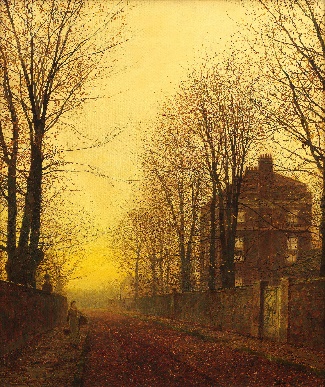
A Golden Idyll
by John Atkinson Grimshaw
The sale did moderately well considering the state of the nineteenth-century market. Of the ninety-seven available lots, thirty-two sold within their estimates, giving Bonhams specialists a 33% accuracy rate. Fifteen lots (15%) sold below their estimates, while seventeen (18%) sold above. The remaining thirty-three lots (34%) went unsold. The one prominent disappointment at Bonhams that day was one of the unsold works. Predicted by specialists to be at the top lot of the day, Fardeau Agréable is a large pastoral portrait of two young girls by the French Academic master William Adolphe Bouguereau. Created in 1895, the painting has spent nearly its entire life in the United States, with it being part of a number of American gallery inventories and private collections after Knoedler & Co. initially sold it not long after receiving it from Bouguereau himself. The last time it sold at auction was at Parke-Bernet in 1966. When Bonhams exhibited the painting in New York, we went to take a look. Its murky varnish makes it difficult to assess its true condition, yet Bonhams specialists gave the painting an estimate range of £800K to £1.2 million. When the time came, interest in the painting was insufficient to reach the reserve, and it wound up bought in.
Even though the Bouguereau brought down the overall amount the sale was predicted to bring in, it wouldn’t be fair to look only at the amount of money. 33% is still an impressive accuracy rate from Bonhams. Furthermore, several works sold far over their estimates, including the Whistler. The biggest surprise of the day, though, was a painting by the early twentieth-century Russian artist Alexander Alekseev. Little of the artist’s work has come to auction, yet the two paintings featured at Bonhams did remarkably well. The cityscape Capri achieved £17K / $22.8K (or £21.7K / $29.1K w/p) against a £6K high estimate, bringing in more than double what was expected. Even better, though, was A Capri Terrace. With the same estimate as the other Alekseev painting, this one proved more popular with bidders, selling for £25K / $33.5K (or £32K / $42.8K w/p), over four times its high estimate. The entire sale brought in just over £2 million / $2.7 million. Even though the pre-sale low estimate was £2.75 million, this is mainly because of the Bouguereau. Removing the Bouguereau from the sale would have brought the pre-sale minimum estimate down to £1.9 million.
____________________
Deeper Thoughts
Vasari Ceiling Reassembled in Venice

The Allegory of Charity
by Giorgio Vasari
After decades of work, the painted ceiling of a Venetian palace created by painter and biographer Giorgio Vasari has been completely reconstructed and restored.
The Palazzo Corner Spinelli is a palace on the Grand Canal in Venice. It is incredibly significant for art historians as it is one of the city’s most prominent works of transitional architecture. It shows the fifteenth- and sixteenth-century Venetian elite moving away from the Gothic style and more towards Renaissance designs. However, it is also important for the arts because its occupants, the wealthy Corner family (or Cornaro in standard Italian), were patrons of Italian artists such as Tintoretto and Gian Lorenzo Bernini. In 1542, Giorgio Vasari completed a series of panels of allegorical figures for the ceiling of the palace’s grand room. However, the Corner and, later, the Spinelli families completely sold off and dispersed the paintings by the end of the eighteenth century. Starting in 1987, the Italian government began helping museums in Venice purchase the Vasari panels to reunite them once more. And now, thanks to a collaboration between the Italian Culture Ministry, the Gallerie dell’Accademia, and several other museums, charities, and nonprofits, the paintings have been restored and reassembled in the Gallerie dell’Accademia’s Palladio Wing.
There were originally nine panels showing five main allegorical figures representing the virtues of charity, faith, hope, justice, and patience. The other four panels contain putti, or naked male cherubs, one of which remains missing. The government and many cultural organizations have gone to great lengths to locate and retrieve the Vasari paintings. The Faith panel was purchased from a private collection in 2013 for the project. Even though the Culture Ministry provided most of the funds, small cultural charities like the Venice in Peril Fund contributed thousands of euros towards its purchase. Ironically, the Hope painting was the last to be tracked down and purchased in April 2017 from a British private collection. Other organizations that provided funding and aid in the project include the Venetian Museum Center, the Fondazione di Venezia, Venetian Heritage Inc., Vela S.p.A., MSC Cruises, SAVE S.p.A, the New Venice Consortium, and the Veneto Banca Foundation. Cultural Minister Gennaro Sangiuliano commented, “The important research and fundraising campaign that allowed the reacquisition of the work is further confirmation of how necessary and fruitful the relationship between public and private is in the protection and valorization of Italian cultural heritage.”
The research done to reassemble nearly the entire work resulted in one painting being identified as part of the Palazzo Corner Spinelli panels. Researchers made this discovery after years of the painting sitting in the Casa Vasari Museum in Arezzo. The Suicide of Judas was previously believed to be a painting made separate from the allegorical figures. However, research has shown that someone cut it from the Hope panel. It indicates that other sections, still missing, may show cautionary tales or what the Italian arts newspaper Finestre sull’Arte calls an “interpretative key of the iconology of the individual sections, attributing new meaning to the unity of the composition.”
The Gallerie dell’Accademia unveiled the reassembled work to the public this past Wednesday, August 28th.
Making A Collage From Canaletto
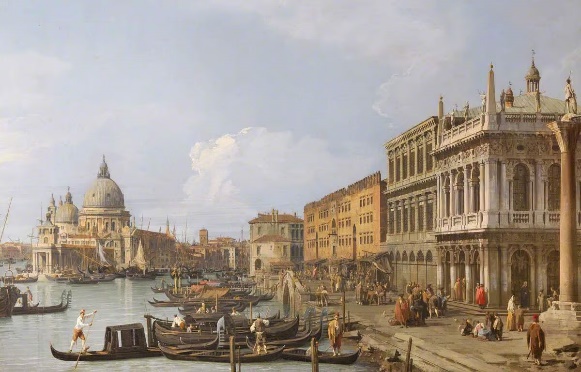
The Grand Canal, Piazzetta and Dogana, Venice
by Canaletto
A British manor house will soon host a program allowing visitors to disassemble and rearrange cityscapes by one of Venice’s most renowned painters: Canaletto.
Tatton Park is an estate in Cheshire overseen by the National Trust. It includes a manor house, extensive gardens, and a farm. The house often hosts exhibitions, drawing from its own collection from when the wealthy Egerton family lived there. The Egerton collection includes two paintings and four etchings by the Venetian painter Giovanni Antonio Canal, popularly known as Canaletto.
Canaletto was an incredibly popular painter among the European aristocracy, particularly in Britain, as a result of the Grand Tour. This tradition was for continental Europe’s wealthy and landed young men between the late seventeenth and early nineteenth centuries. It was a rite of passage of sorts, consisting of young men traveling throughout Europe to experience the continent’s art and culture, with a great amount of emphasis placed on the cities of Italy. As a result, many young aristocratic men returned from their adventures with a trove of art and other souvenirs they picked up on the way. I’ve previously written about one of these items when a small Scottish town considered selling off a marble bust worth £2.5 million. The bust of Sir John Gordon, a local aristocrat and later a member of Parliament, was created by the renowned French sculptor Edmé Bouchardon during his time working in Rome. The subject would have been around twenty years old at the time and likely commissioned the bust while on the Grand Tour through Italy. While portraits and busts were popular among these tourists, detailed cityscapes and landscapes were desirable as well. Canaletto soon became one of the greatest names in European painting for his lively Venetian cityscapes. His paintings can be found in many of the world’s great museums and even in the private collections of the British Royal Family and the Prince of Liechtenstein.
The two Canaletto paintings at Tatton Hall were likely brought to Britain in 1730 by Samuel Hill, uncle to the manor’s future owner Samuel Egerton. One is The Grand Canal, Piazzetta and Dogana, looking westward at the entrance of the Grand Canal close to the Pizza San Marco. The other is called The Doge’s Palace and Riva degli Schiavoni, which depicts the same place as the other painting but viewed from the opposite direction. Despite many Canalettos making their way to Britain as a result of young aristocrats on the Grand Tour, the two paintings at Tatton Hall were likely not obtained this way. Hill was close friends with Joseph Smith, the British consul in Venice, through whom he would buy and import Venetian paintings. The paintings and many other works by Canaletto serve as important documents in studying Venice’s urban development. Both paintings feature buildings that have either been significantly altered or do not exist anymore.
Tatton Park plans to use the Canaletto paintings in an extended reality experience at a free event in late September. This will educate visitors on how the paintings arrived at Tatton Hall and allow them to rearrange the components from the paintings to create their own capriccio-style cityscapes. After the September event, technicians and other specialists will further develop the experience so that it can be unveiled to the public sometime in 2026.
Artemisia Acquisition Spurs Debate In Texas
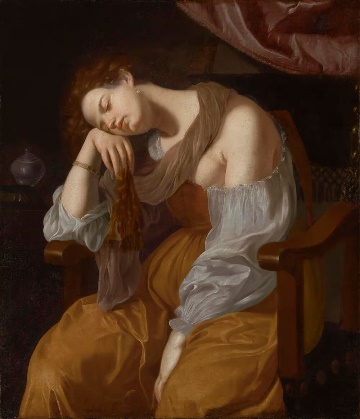
Penitent Mary Magdalene
(Kimbell version) by Artemisia Gentileschi
The Kimbell Museum in Fort Worth, Texas, has just acquired a painting by the seventeenth-century Italian artist Artemisia Gentileschi. But the museum may make some waves with a bold claim.
Even though the Kimball Museum’s collection is relatively small compared to other major American museums, the contents are undoubtedly impressive. It is often considered one of the best art collections in the American Southwest, boasting such highlights as Caravaggio’s Cardsharps and Caillebotte’s On the Pont de l’Europe. The Gentileschi acquisition is the painting Penitent Mary Magdalene, which the museum unveiled last week on September 5th. The Penitent Magdalene was a popular subject among Renaissance and Baroque artists. She closes her eyes in contemplation, making Artemisia’s take on the subject rather different from other masters. Most paintings and sculptures of the Penitent Magdalene show her at the moment of conversion. Her eyes are often widened with awe as a light shines on her. This is apparent in paintings by Titian, El Greco, and even Artemisia’s father, Orazio Gentileschi. Keith Christiansen suggests that the pose of Artemisia’s Magdalene, her head lolling off to the side, is reminiscent of depictions of the crucifixion, lamentation, and entombment of Christ, with the surrounding figures bowing their heads with grief. Artemisia further distinguishes her Magdalene from others by refraining from showing nudity. These other Penitent Magdalene paintings all show the saint bare-breasted to indicate her previous life of sin. But Artemisia does not do that. Artemisia shows the saint with pearl earrings and a gold bracelet, representing a past life of sin by decorating her with luxurious trinkets, serving as remnants of vanity. This makes Artemisia’s version more like Caravaggio’s realistic Magdalene. The subject is also consistent with Artemisia’s penchant for strong or heroic female figures of history, mythology, and the Bible, including Lucretia, Judith, and Cleopatra.
The Kimbell Museum, however, is going against the wider academic consensus. Art historians generally agree that Gentileschi’s original Penitent Mary Magdalene hangs at Seville Cathedral’s treasury. But the Kimbell seems to assert that the Seville painting is a later copy. According to the museum’s press release, the painting was “famous and was widely copied. Yet despite its fame, the original painting subsequently disappeared. Notable copies include canvases today in Seville Cathedral and the Museo Soumaya in Mexico City.” It implies that the Seville painting is the creation of a student or a young artist making a copy or a study of a great masterwork. Art historian Mary Garrard writes that the Seville painting is “unquestionably by Artemisia’s hand.” Garrard claims the Kimbell painting is also by Artemisia herself, but it is “a replica of [the Seville painting’s] design”. Other sources, like the Saint Louis Art Museum’s 2002 Gentileschi exhibition, claim that both the Seville and Kimbell versions are Artemisia’s copies of the lost original.
The most striking difference between the Kimbell and Seville versions is the veil draped over the saint’s shoulder. In the Seville painting, the cloth is wider and covers more skin. Some speculate that this was added later to appease the Church. The absence of this addition in the Kimbell version has led art historians to theorize that the Kimbell version was painted directly from the Seville version before the extra drapery was added.
The original painting, likely the Seville version, was created around 1625 and purchased by the Duke of Alcalá, who later served as the Spanish viceroy of Naples. Some conclude that the Seville painting is the original work commissioned by the Duke. However, art historians Jonathan Brown and Richard Kagan note that the Penitent Magdalene was not listed in the Duke of Alcalá’s inventory when he transferred his collection from Naples to Seville. Therefore, the version in Seville today may be another version Artemisia made. Garrard uses several art collection inventories to deduce that Artemisia may have sold a copy to the legal scholar Ettore Capecelatro, whose estate later sold it to the banker Davide Imperiale. From there, the painting went to Imperiale’s home city of Genoa. There, the trail ends, but Garrard suggests that it’s likely that this second version is the same painting that turned up at the Tajan auction house in Paris in 2001 and now hangs at the Kimbell Museum in Texas. This, however, does not mean the Kimbell version is the original. Several scholars note that the Kimbell version seems a little more roughly done. Garrard notes that some aspects seem to have been done “in a slightly more generalized, somewhat stylized, manner.” Furthermore, the hand brought up to the face is “painted far more meticulously” in the Seville painting. The Seville version seems more like the kind of painting that would be presented as a commission from a prominent patron.
The Kimbell Museum’s director, Eric Lee, described the painting as “newly rediscovered”. I suppose there’s a bit of truth to the statement. When it came up in Paris in 2001, Tajan attributed the painting to Artemisia’s studio. So, assigning the work a full attribution to Artemisia and claiming it’s the original painting will surely provoke some interesting debates within the realm of Old Masters scholarship.
Monet Makeover: Churchill-Owned Painting Restored
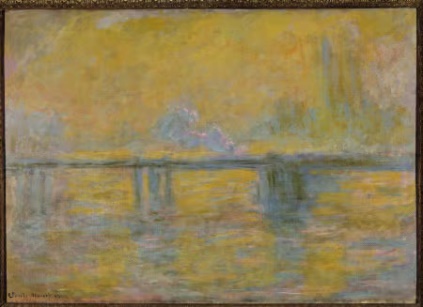
Charing Cross Bridge
by Claude Monet (prior to cleaning)
In June, I wrote about how the Courtauld Gallery will open an exhibition dedicated to Claude Monet’s London paintings. The exhibition will open this Friday, September 27th, but not before gallery and National Trust specialists make some last-minute changes. This includes fully restoring a painting previously caked in decades of cigar smoke from its prior owner, Sir Winston Churchill.
Monet had an interesting relationship with London. He first traveled there in 1870, mainly to escape the Franco-Prussian War. The city’s galleries and museums exposed him to the art of J.M.W. Turner and John Constable, influencing how he would execute his later landscapes. Monet later painted in London, creating around a hundred paintings over several visits, mainly showing spots on the River Thames, such as the Houses of Parliament and Waterloo Bridge. Starting September 27th, the Courtauld Gallery will exhibit a collection of twenty-one paintings to recreate the artist’s plans for exhibiting these paintings in London in 1905. One of these works, however, had to undergo substantial cleaning and restoration because of its previous owner, British Prime Minister Sir Winston Churchill.
The painting from Churchill’s collection was mostly completed in 1902, but Monet made small changes here and there over many years before he sold it in 1923. The painting looks southwest down the Thames towards Charing Cross Bridge, with the faintest hint of Big Ben on the right-hand side in the distance. Today, Charing Cross Bridge is used mainly for rail, with two additional pedestrian bridges on either side opening in 2002. Churchill kept the Monet in the drawing room of his country estate in Kent, Chartwell House. He received it for his 75th birthday in 1949 from his friend and literary agent, Emery Reves. In a letter, Reves wishes Churchill a good year, during which he appropriately wishes he “will dissipate the fog that shrouds Westminster.” Churchill was Leader of the Opposition at the time and would live up to Reves’s wishes, winning the 1951 elections and regaining the position of Prime Minister. After Churchill died in 1965, his widow Clementine gave Chartwell and its contents to the National Trust, marking the first time Charing Cross Bridge was part of a public collection. But even then, the Monet remained little-known, with it even missing from Daniel Wildenstein’s catalogue raisonné published in 1985.
Over the decades, smoke from fireplaces and the thousands of cigars Churchills smoked each year gradually darkened the painting’s varnish until the subtleties of the color became more difficult to notice. Rebecca Hellen, a conservator for the National Trust, posed for a photo with the mostly-cleaned Monet. The bottom-left corner of the canvas remained uncleaned in the photo to show the differences in color. As one of only two Monet London paintings in British public collections, the Churchill Monet is a particularly consequential loan for the Courtauld Gallery to secure. Monet and London: Views of the Thames will be on display at the Courtauld Gallery from September 27, 2024 to January 19, 2025.
____________________
Oldies, But Goodies
A Story About Altering Provenance
(from 2020)
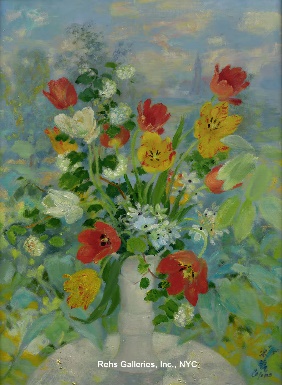
Le Pho
As we have always said, every work has a provenance, but the full provenance of every work is not always known. Now, you should expect that when one of the major auction rooms offers a work, they will do their best to have as complete a provenance as possible. Well, as you will soon see, that is not always the case.
In November of 2019, our gallery acquired a beautiful still life by the Vietnamese artist Le Pho. In July, a collector of Vietnamese art purchased the painting and was very happy with it. In October, while looking through all the auction sites, we noticed that a Modern & Contemporary sale was taking place in Hong Kong and decided to see what was included. Lo and behold, the Le Pho we sold was in the sale with an estimate of HK$150-260K ($19,335-33,514) … which was much less than we sold it for. It seemed odd, but what do I know?
Anyway, while looking at the catalog entry, I noticed the following provenance:
Wally Findlay Galleries, USA
Acquired from the above gallery by the previous owner
Private Collection, USA
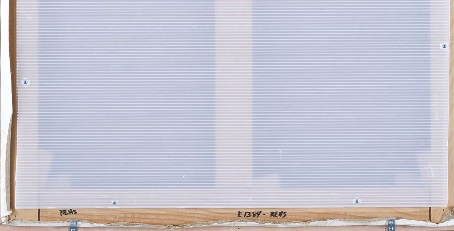
Verso - detail
I found it strange that they were inferring that our gallery bought it from Wally Findlay, when, in fact, we bought it from a collector who acquired it years ago. Also, our name ‘Rehs’ and the inventory number are visible on the stretcher. On October 12th, I decided to write an email to Christie’s and let them know that their cataloging was incorrect.
I noticed that you are offering a painting by Le Pho – lot 19. Your provenance is not complete. We sold that painting this year (I assume to the seller).
https://rehs.com/Le_Pho_Les_Tulipes_Tulips_Viburnum_and_Anemones.html
You will also note in the image you feature on your site that the name REHS (along with our inventory number) is written at the bottom of the stretcher.
On the 15th I received a reply from Winnie Wan:
Dear Mr Rehs,
Thank you very much for highlighting the provenance of lot 19.
We generally do not include past auction records from auction houses apart from Christie’s and Sotheby’s. Hence, for us this auction record is considered complete. However, for any enquiries we can mention it.
Should you have further concerns, please feel free to contact us.
My reply to Ms. Wan:
We are not an auction house … we have an art gallery in New York City. We bought that painting and then sold it to the individual who is now selling it. [W]e owned the painting outright (had clear title), so your provenance is not complete as stated in the catalog. Of course, you can sell it as you see fit, but do note that I have now told you your provenance is incomplete.
I never received a reply. Now I am sure you are thinking, what did the painting make? HK$625,000 ($80,634) … yes, that was more than we sold it for.
The word ‘provenance’, according to the dictionary, is a record of ownership of a work of art or an antique, used as a guide to authenticity or quality. The key word here is ‘ownership.’ As a previous owner, the gallery’s name should have been included. Also, an auction room should almost never be included in the provenance since they never (or rarely) own the work being sold. They are a middleman, and as they have always stated, title passes from the seller to the buyer when the hammer falls.
We see this time and again, auction rooms leaving out parts of the provenance that might make the sale more difficult. The salerooms are always trying to make people believe they are being as transparent as possible … obviously, that is a bunch of …
Ever Been To Disney’s It’s A Small World?
(from 2013)

Howard Rehs
My thoughts on the recent auction sales that have taken place, and I try to answer the big question on people’s minds: where has all the good art gone? I have been saying this for a very long time — there are just too many sales and not enough really good works to fill them. If this continues, we could be in for one wild ride!!
After May’s $1.5 Billion worth of art that traded hands in a matter of 2 weeks in New York, one might have felt that the art world needed a rest, and you are probably right. However, the salerooms were not going to let that happen and moved the auction action over the pond to Merry Old England. Hey, why not milk the market for as much as you can get, as fast as you can? It’s not a great strategy, in my humble opinion, but if you are just in it for some fast money, I guess it works.
By the middle of the month, both main salerooms presented another round of Impressionist / Modern and Contemporary art sales – at least they are waiting until July for their Old Master sales – oh wait, that is only next week. And once again the press was abuzz with the thought that another Billion dollars worth of art might sell. In addition, I found it very interesting to read that other dealers and some press people are now concerned that there may be too many sales since there appears to be a ‘shortage’ of quality material coming to the auction block. The big question on everyone’s mind is – where have all the good works of art gone? The simple answer is that they are hanging on people’s walls.
Now, for what I feel is a more all-encompassing answer. Over the past decade, the major market players have been really pushing the idea that art is a great investment, and while I agree that over a long period of time, most works of art, by well-established artists, will do well, I am still a firm believer that one needs to buy art because they love it and want to own it … not just to make money — remember, nobody can guarantee that each work you buy will go up in value. In addition, there are now a number of art funds that will be happy to take your money and invest it in works they feel will bring you great rewards. So, with all the talk about investing in art and many of the major money people buying into it, you have to assume that at some point, most of the really good works will be in private collections (and do not forget that some will be in those art funds). On top of that, the banks are paying almost nothing in interest (at times, I feel like I am paying them to hold on to it), and the stock market, while it has made great strides over the past few years, is still one big roll of the dice – come on 7 – and let’s not forget the wild swings it takes which can really take its toll on your mental health. So, if your money is doing nothing in the bank, and you are not ready for a game of craps or the volatility of the market’s daily swings, the art market seems to be a nice calm place to park some of your greenbacks. There are no daily ups and downs (at least that you can see or read about); you can dream about the big score when you decide to sell, and you get the added bonus of enjoying the works that you own (unless they are part of an art fund). So why should people sell? If they do not need the money they are not and that is part of the reason why less stellar works are coming to the market.
Of course, bigger issues will surface if all of the great private collections are donated to public or private museums with the caveat that they cannot be sold; but the odds of that happening are pretty slim. Many of the large players in today’s market are young and it will be a long time until they (or their estates) want or need to sell. That is not to say these buyers will not tweak their collections as time goes on, but it also does not mean that those works will appear on the auction block — yes, we dealers do sell a lot of work that never goes through the auction houses … there are many 5, 6, 7, 8 or even 9 figure transactions that take place in the private sector of the market. On top of that, the auction rooms now offer ‘private’ sales … so they are adding to the public’s perception that the great works are drying up … it is hard to have your cake and eat it too.
The real interesting part is that as the supply has dwindled, the number of people coming to the market has increased. Some of these new buyers are beginning to pay high prices for average works of art … in the grand scheme; I guess that is a double-edged sword. The sellers of these ‘average’ works are very happy, but at some point, the market for the ‘average’ will get so high that people who own the better pieces will want to sell just to cash in … and that is when the crap may hit the fan. I say ‘may’ because it all depends on how much good art comes on the market at any one time. If the works flow into the market in an orderly fashion, they should be easily absorbed, at very strong prices, and only help support the middle-level works; but if too much comes out at one time, hold on to your hats … it will make that initial drop on Six Flags’ Kingda Ka feel like a ride through Disney’s It’s A Small World!!
Best wishes,
Howard
How To Safely Navigate The Art Market – Condition
(from 2019)
While we would all like to only own works that are in perfect condition, often this is just not possible. Works created years, decades, or centuries ago may have been bought and sold numerous times, and each time they reappeared on the market, they may have been cleaned or restored. If the individual handling the restoration was an expert, then there was little chance of any damage being caused during the restoration process; however, this is usually not the case. Many times, works are handled by individuals unfamiliar with the specific
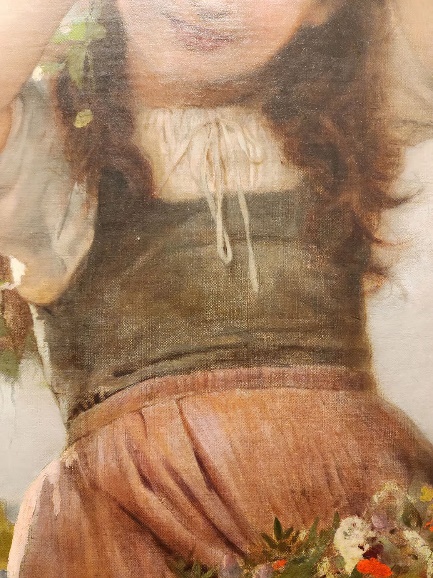
Overcleaned / Skinned
artist’s materials, and that is when problems can arise – over-cleaning or skinning the paint surface, extensive in-painting, etc. In addition to the potential damage caused by a ‘bad’ conservator, there is the ever-present ‘accident’ factor. A work of art may have been damaged when it fell off the wall, while it was being moved, or when one of the kids threw something or stepped on it (seen that)! As dealers, we have witnessed many unusual things; the most unique was a work that was cut in half to make a pair of paintings!
When considering a work of art, it is important to know if it was restored and, if so, what was done? I remember having a conversation with a client, and they mentioned that they would “have to think long and hard before they bought a work of art that was re-lined” (a process in which a new canvas is affixed to the back of the old canvas). I explained to them that a re-lining is not necessarily bad and they should not discount a painting because of it. If the re-lining process was done for cosmetic, or for certain structural, reasons, then there is nothing wrong with acquiring the work. Over the years, certain pigments artists used begin to crack and lift. The only way to reduce the look of those cracks is to treat and re-line the painting (chemically treating the canvas and pigment so they relax – causing the lifting paint to flatten – and then adhering the old canvas to a new one to stabilize the work). There are also times when a painting’s tacking-edge (the unpainted part of the canvas used to hold it to the stretcher) has begun to tear, and the painting is no longer securely affixed to the stretcher bars. In order to repair this, a conservator may have to do a strip lining (affixing a narrow piece of canvas to all sides so the work can be reattached to the stretcher) or a full re-lining.

Extensive inpainting
Of course, some linings are done to repair damages. If this is the case, then you need to know what type of damage occurred (small puncture, large tear, etc.) and where the damage is located. For my illustration, I need you to imagine that you are looking at a painting of a sailing ship. With marine paintings, it is important that the ship and its rigging are in excellent condition; if there are some areas of restoration in the sky or water, they will have little impact on its value. Collectors and many museums are often interested in the ship and are not too concerned with the background area. In other words, if the central focus of the painting (the ship) has been restored, it will have a greater impact on the work’s value than if the background areas have been restored. This is also true with figurative works. If there is some minor restoration in the background areas, but the figures are in good shape, there is not much to worry about. Please note that I used the words ‘some minor’ – you do not want to buy a work of art where extensive areas of the background have been restored.
With all that said, it is important to understand that condition is a key factor when considering and valuing a work of art – especially historical works. If you were lucky enough to find two almost identical paintings by an artist and one is in excellent or pristine condition, and the other has restoration, the one in better condition is going to be more valuable — and it should be.
Over-cleaning, damages, in-painting, and re-lining are just some of the things to be aware of when trying to understand and assess a work’s true condition. Sometimes they will have a great impact on value, and other times they do not.
The Rehs Family
© Rehs Galleries, Inc., New York – October 2024
